How Ella’s Kitchen grows using hybrid

Organic baby-food business and APM award winner Ella’s Kitchen is a fast-growing firm with 70 employees and a turnover of £70m. Ellen Jarrett was brought in as programme manager in 2016 to start a project management function and instil processes that would cut through the chaotic approach the company had previously taken towards projects.
“For a long time, there had only been 20 people in the business, but that doubled quite quickly in a few years. Everything was a bit disorganised and no one was really owning the projects. It was getting a bit too chaotic, things were getting forgotten, mistakes were getting repeated,” she recalls.
When she arrived, Jarrett found 40 projects running with only 60 people in the business: “There were about 20 new-product projects, and a lot of people were on ten project teams. Every project had an Excel spreadsheet as its action, issues and decisions register. There were 40 Excel files, and one person might have actions in 15 of those. It was impossible for anyone on a project team to know what their actions were or when they were due. It was really stressing them out.”
Read more on hybrid:
PRINCE2 plus
Today, Jarrett and her project manager take a hybrid approach. “We run the team, tolerances and change requests in a PRINCE2-type way, but everything isn’t set in stone at the beginning, because things change so much at every stage,” she says. She put in an online project management system called Teamwork Projects, so that anyone in the business can log in and view their actions across all of their projects.
“It has revolutionised people’s interaction with projects, making their lives infinitely easier,” she says. The number of project team meetings was drastically reduced, giving people back a lot of time and autonomy.
Two different kinds of (Ella-friendly) projects
There are two different kinds of projects at Ella’s Kitchen: product projects (such as making a new baby-food flavour) and internal projects (such as changing a supplier). Internal projects follow a process based on PRINCE2. It has four stages and everything has been renamed to make it ‘Ella-friendly’. “Instead of a ‘business case’ we have a document called a ‘worth it’, and our project initiation planning stage is called a ‘put your ducks in a row’,” Jarrett explains.
The product projects have a five-stage gate process, and are a mix of agile and PRINCE2, which is common in other Fast-Moving Consumer Goods (FMCG) businesses, says Jarrett. The first stage is the business analysis (they call it the ‘homework’), while the second is a gate document that brings the project to the senior management team with all its key information. The third gate is when samples are created in-house, and the fourth gate is when it is trialled in a factory. If that works, it returns to the senior team for approval. The fifth gate is a benefits review about six months after the launch.
It’s working so well that Jarrett says people are coming to the project management office asking to run projects formally. “I think it surprised them,” says Jarrett.
This story originally appeared in the Summer 19 edition of Project journal. Project is free to all APM members.
Don't know which methodology is right for you? Learn more about choosing the right life cycle in APM Learning.
Image: Auttapon Wongtakeaw/Shutterstock.com


0 comments
Log in to post a comment, or create an account if you don't have one already.